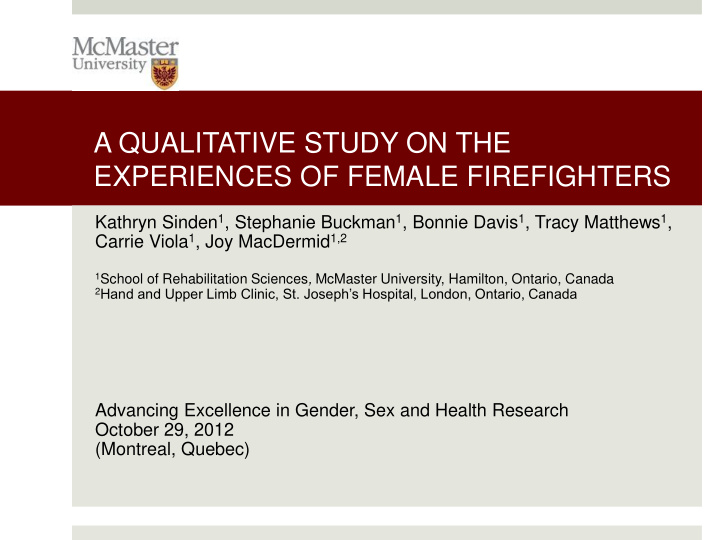



A QUALITATIVE STUDY ON THE EXPERIENCES OF FEMALE FIREFIGHTERS Kathryn Sinden 1 , Stephanie Buckman 1 , Bonnie Davis 1 , Tracy Matthews 1 , Carrie Viola 1 , Joy MacDermid 1,2 1 School of Rehabilitation Sciences , McMaster University, Hamilton, Ontario, Canada 2 Hand and Upper Limb Clinic, St. Joseph’s Hospital, London, Ontario, Canada Advancing Excellence in Gender, Sex and Health Research October 29, 2012 (Montreal, Quebec)
Overview • Background • Methods • Results • Seven Themes • Potential Impact of study results on Research, Policy and Practice
Background • Firefighting is a physically demanding, male dominant occupation (Hulett et al., 2008) • Adverse health effects are experienced by gender minorities in occupational contexts ( Evans and Steptoe, 2002) • Female firefighters experience 33% more injuries than male firefighters (Liao et al., 2001) • Female firefighters experience the physiological and physical demands of firefighting differently then men (Misner et al., 1987, Rhea et al., 2004, Sheaff et al., 2010, Williams-Bell et al., 2009)
Study Purpose To explore how a male dominant, physically demanding work environment influences female work health and job satisfaction through exploration of the negative and positive experiences of female firefighters.
Methods • Descriptive, phenomenological approach • Participants • 4 female firefighters • Conducted semi-structured telephone interviews • 45 minutes • Questions designed to elicit responses regarding job expectations and attitudes and work injuries
Analysis • Inductive thematic analysis approach (Braun and Clarke, 2006) • identify, analyze and report themes independently from theoretical frameworks • Prevalent statements, ideas and contemplations identified and reviewed with all researchers • “Member checking”
Results Physical Demands / Difficulties “Mentally, I knew that I could do it (firefighting) but physically that was more what I was concerned about. ” “…you have to have endurance, to be a firefighter…your adrenaline helps you get through…it helps you advance the hose line up and helps you to put the fire out but then after that the adrenaline is gone and you still have to take down the ceiling and the walls and break up the floors so you really need endurance. ”
Results Gender Related Physiological Differences “…for a woman it is difficult because you are working above your head and our upper body strength is not the same as a mans because that is just the way we are built…” “Females are already 20% not as strong as their male counterparts…so you really have to maintain that or you’re going to be weaker.”
Results Compensatory Strategies “Body mechanics more than anything…the guys can usually manhandle things; I had to learn to use my body a bit more effectively.” “There can’t be anything we can’t do or else we’re never going to be accepted… in the fire department you have to learn to never ask for help… you have to figure out how and just find a way…just do it!”
Results Equipment Mal-Adaptation “The boots are always too big on me and the bunker pants…everything is just kind of big and fits more loosely because it’s suited more for a man. They do have female gear out there but we don’t have it.”
Results Earning Respect “You have to earn your stripes basically, you know what I mean…their respect. A lot of women walk right on the job expecting their respect and you have to earn it…”
Results Negative Attitudes of Male Counterparts: Impact on Social Exclusion and Health Behaviors “Some people have attitudes that aren’t going to change no matter what you do, no matter how good of a firefighter you are…you’re a woman in man’s job and you shouldn’t be here.” “..They (male counterparts) refused to train us because they didn’t want us to be good. Because if we were good, then I guess they wouldn’t look masculine maybe, I don’t know…..they wouldn’t even let me play basketball with them because it was a ‘boy’s club’.”
Results Recognition of Injury Risk “I don’t think that there’s a difference because I’m a female…. Generally a lot of the time when you get injured it’s the back because you’re lifting the wrong way and you injure your back…you get a little bit out of shape so you don’t do things properly.”
Impact of Study Results Research • Continue to explore how socio-cultural constructs overlay physical demands and affect female health and well-being • Consider male perspectives and experiences in similar occupational contexts Policy • Explore developing sensitivity training and developing programs to facilitate integrating women in male dominant work environments Practice • Consider gender and sex differences when developing equipment and training programs.
Acknowledgements • We thank the women who participated in this study and contributed their experiences of firefighting. • KS is supported by the Joint Motion Program – A Canadian Institutes of Health Research Training Program in Musculoskeletal Health Research and Leadership and by an Ontario Graduate Scholarship . • Portions of this work were supported in part by an Operating Grant from the Canadian Institutes of Health Research (PHE-114112) . • The manuscript of this work is in press at Work: A Journal of Prevention, Assessment and Rehabilitation.
Discussion and Questions
Recommend
More recommend